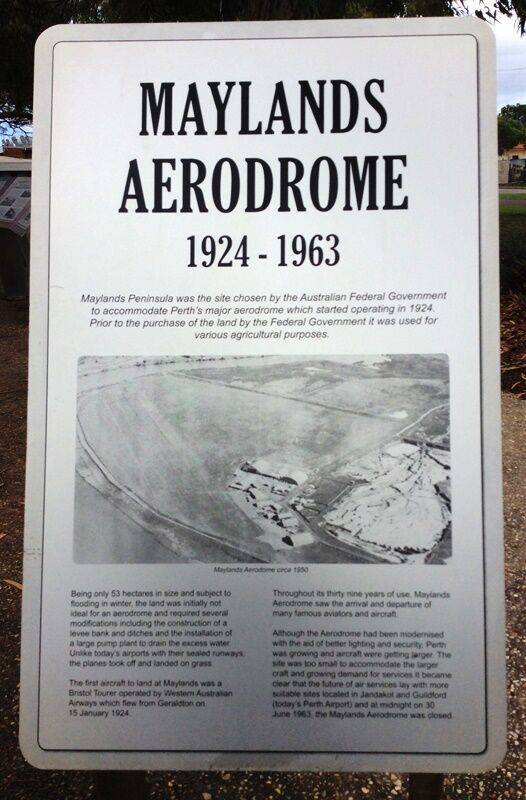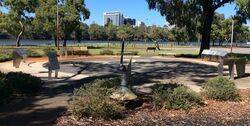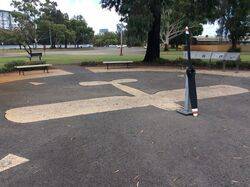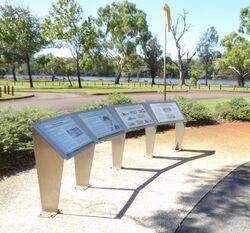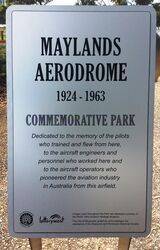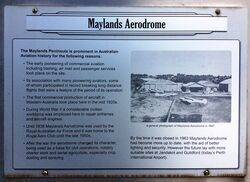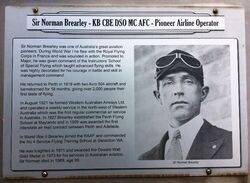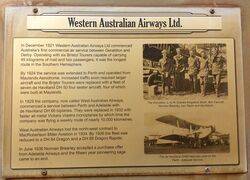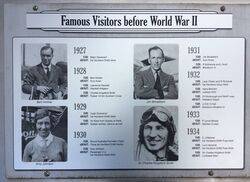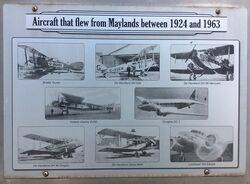
Home » Themes » Technology » Industry
Maylands Aerodrome Commemorative ParkPrint Page 
The park commemorates the pilots, aircraft engineers, and aircraft operators who worked at the Maylands Aerodrome from 1924 to 1963.
The park is located on the site of the former Maylands Aerodrome and marks the aerodrome’s historical significance as the birthplace of commercial aviation in Western Australia and its role as Perth’s first official airport which operated between 1924 and 1963.
The centrepiece of the park is an outline of a Bristol Tourer Aircraft set in a seven metre concrete circle. A pathway around the centrepiece contains 16 information plaques.
The plaques commemorate five aviators and the companies they operated out of Maylands Aerodrome. They are Sir Norman Brearley, Western Australian Airlines Ltd, Horrie Miller OBE, MacRobertson Miller Aviation Company Ltd, Charles Snook, Airlines (WA) Ltd, Harry “Cannonball’ Baker, Baker Aviation Company and Jimmy Woods MBE, Woods Airways Pty Ltd.
Other plaques commemorate aircraft that flew from Maylands between 1924 and 1963, famous visitors before World War Two, the establishment of the Royal Aero Club of Western Australia, early civil operators at Maylands, the Royal Australian Airforce at Maylands and Maylands Aerodrome during World War Two.
Location
| Address: | Clarkson Road, Maylands, 6051 |
|---|---|
| State: | WA |
| Area: | AUS |
| GPS Coordinates: | Lat: -31.950591 Long: 115.907571 Note: GPS Coordinates are approximate. |
Details
| Monument Type: | Park |
|---|---|
| Monument Theme: | Technology |
| Sub-Theme: | Industry |
| Approx. Event Start Date: | 1924 |
| Actual Event End Date: | 30-June-1963 |
Dedication
| Actual Monument Dedication Date: | Saturday 10th November, 2012 |
|---|
MAYLANDS
AERODROME
1924 - 1963
COMMEMORATIVE
PARK
Dedicated to the memory of the pilots
who trained and flew from here,
to the aircraft engineers and
personnel who worked here and
to aircraft operators who
pioneered the aviation industry
in Australia from this airfield.
Plaque :
MAYLANDS
AERODROME
1924 - 1963
Maylands Peninsula was the site chosen by the Australian Federal Government to accommodate Perth`s major aerodrome which started operating in 1924. Prior to the purchase of the land by the Federal Government it was used by various agricultural purposes.
Being only 53 hectares in size and subject to flooding in winter, the land was initially not ideal for an aerodrome and required several modifications including the construction of a levee bank and ditches and the installation of a large pump plant to drain the excess water. Unlike today`s airports with their sealed runways, the planes took off and landed on grass.
The first aircraft to land at Maylands was a Bristol Tourer operated by the Western Australian Airways which flew from Geraldton on 15 January 1942. Throughout its thirty nine years of use, Maylands Aerodrome saw the arrival and departure of many famous aviators and aircraft.
Although the Aerodrome had been modernised with the aid of better lighting and security, Perth was growing and aircraft were getting larger. The site was too small to accomodate the larger craft and growing demand for services. It became clear that the future of air services lay with more suitable sites located in Jandakot and Guildford (today's Perth Airport) and at midnight 30 June 1963, the Maylands Aerodrome was closed
Plaque :
Maylands Aerodrome
The Maylands Peninsula is prominent in Australian aviation history for the following reasons :
- The early pioneering of commercial aviation including training, air mail and passenger services took place on the site.
- Its assocation with many pioneering aviators, some of whom participated in record breaking long distance flights that were a feature of the period of its operation.
- The first commercial production of aircraft in Western Australia took place here in the mid 1920s.
- During World War II a considerable civilian workforce was employed here to repair airframes and aircraft engines.
- Until 1938 Maylands Aerodrome was used by the Royal Australian Air Force and it was home to the Royal Aero Club until the late 1950s.
- After the war the aerodrome changed its character, being used as a base for civil operations, notably charter work and aerial agriculture, especially crop dusting and spraying.
By the time it was closed in 1963 Maylands Aerodrome had become more up to date, with the aid of better lighting and security. However the future lay with more suitable sites located in Jandakot and Guildford (today's Perth International Airport)
Plaque :
Sir Norman Brearley - KB CBE DSO MC AFC - Pioneer Airline operator
Sir Norman Brearley was one of Australia`s great aviation pioneers. During World War I he flew with the Royal Flying Corps in France and was wounded in action. Promoted to Major, he was given command of the Instructors` School of Special Flying which taught advanced flying skills. He was highly decorated for his courage in battle and skill and management command.
He returned to Perth in 1919 with two Avro 504 aircraft and barnstormed for 18 months, giving over 2,000 people their first taste of flying.
In August 1921 he formed Western Australian Airways Ltd. and operated a weekly service in the north-west of Western Australia which was the first regular commercial air service in Australia. In 1927 Brearley established the Perth Flying School at Maylands and in 1929 was awarded the first interstate air mail contract between Perth and Adelaide.
In World War II Brearley joined the RAAF and commanded the No 4 Service Flying Training School at Geraldton WA.
He was knighted in 1971 and awarded the Oswald Watt Gold Medal in 1973 for his services to Australian aviation. Sir Norman died in 1989, age 99.
Plaque :
Western Australian Airways Ltd.
In December 1921 Western Australian Airways Ltd commenced Australia`s first commercial air service between Geraldton and Derby. Operating with six Bristol Tourers capable of carrying 45 kilograms of mail and two passengers, it was the longest route in the Southern Hemisphere.
By 1924 the service was extended to Perth and operated from Maylands Aerodrome. Increased traffic soon required larger aircraft and the Bristol Tourers were replaced with a fleet of seven De Haviland DH 50 four seater aircraft, four of which were built at Maylands.
In 1929 the company, now called West Australian Airways, commenced a service between Perth and Adelaide with De Haviland DH 66 biplanes. They were replaced in 1932 with faster all metal Vickers Viastra monoplanes by which time the company was flying a weekly route of nearly 10,000 kilometres.
West Australian Airways lost the north - west contract to MacRobertson Miller Aviation on 1934. By 1936 the fleet was reduced to a DH 84 Dragon and a DH89 Dragon Rapide.
In June 1936 Norman Brearley accepted a purchase offer from Adelaide Airways and the fifteen year pioneering saga came to an end.


